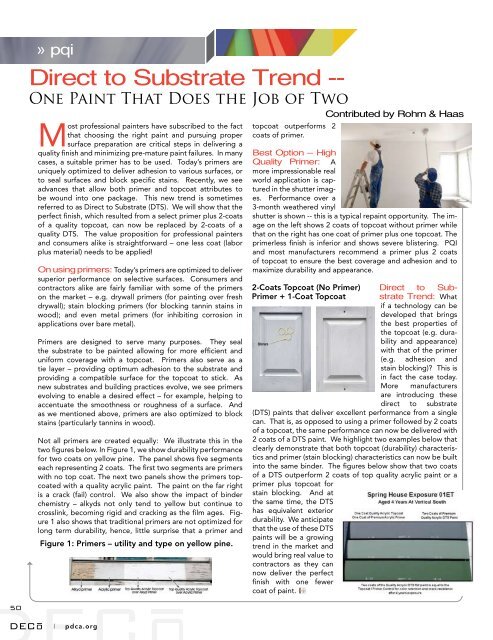n o v/d e c • 2 0 0 8 - Subscribe
n o v/d e c • 2 0 0 8 - Subscribe
n o v/d e c • 2 0 0 8 - Subscribe
You also want an ePaper? Increase the reach of your titles
YUMPU automatically turns print PDFs into web optimized ePapers that Google loves.
50<br />
» pqi<br />
Direct to Substrate Trend --<br />
One Paint That Does the Job of Two<br />
Most professional painters have subscribed to the fact<br />
that choosing the right paint and pursuing proper<br />
surface preparation are critical steps in delivering a<br />
quality finish and minimizing pre-mature paint failures. In many<br />
cases, a suitable primer has to be used. Today’s primers are<br />
uniquely optimized to deliver adhesion to various surfaces, or<br />
to seal surfaces and block specific stains. Recently, we see<br />
advances that allow both primer and topcoat attributes to<br />
be wound into one package. This new trend is sometimes<br />
referred to as Direct to Substrate (DTS). We will show that the<br />
perfect finish, which resulted from a select primer plus 2-coats<br />
of a quality topcoat, can now be replaced by 2-coats of a<br />
quality DTS. The value proposition for professional painters<br />
and consumers alike is straightforward – one less coat (labor<br />
plus material) needs to be applied!<br />
On using primers: Today’s primers are optimized to deliver<br />
superior performance on selective surfaces. Consumers and<br />
contractors alike are fairly familiar with some of the primers<br />
on the market – e.g. drywall primers (for painting over fresh<br />
drywall); stain blocking primers (for blocking tannin stains in<br />
wood); and even metal primers (for inhibiting corrosion in<br />
applications over bare metal).<br />
Primers are designed to serve many purposes. They seal<br />
the substrate to be painted allowing for more efficient and<br />
uniform coverage with a topcoat. Primers also serve as a<br />
tie layer – providing optimum adhesion to the substrate and<br />
providing a compatible surface for the topcoat to stick. As<br />
new substrates and building practices evolve, we see primers<br />
evolving to enable a desired effect – for example, helping to<br />
accentuate the smoothness or roughness of a surface. And<br />
as we mentioned above, primers are also optimized to block<br />
stains (particularly tannins in wood).<br />
Not all primers are created equally: We illustrate this in the<br />
two figures below. In Figure 1, we show durability performance<br />
for two coats on yellow pine. The panel shows five segments<br />
each representing 2 coats. The first two segments are primers<br />
with no top coat. The next two panels show the primers topcoated<br />
with a quality acrylic paint. The paint on the far right<br />
is a crack (fail) control. We also show the impact of binder<br />
chemistry – alkyds not only tend to yellow but continue to<br />
crosslink, becoming rigid and cracking as the film ages. Figure<br />
1 also shows that traditional primers are not optimized for<br />
long term durability, hence, little surprise that a primer and<br />
Figure 1: Primers – utility and type on yellow pine.<br />
| pdca.org<br />
Contributed by Rohm & Haas<br />
topcoat outperforms 2<br />
coats of primer.<br />
Best Option – High<br />
Quality Primer: A<br />
more impressionable real<br />
world application is captured<br />
in the shutter images.<br />
Performance over a<br />
3-month weathered vinyl<br />
shutter is shown -- this is a typical repaint opportunity. The image<br />
on the left shows 2 coats of topcoat without primer while<br />
that on the right has one coat of primer plus one topcoat. The<br />
primerless finish is inferior and shows severe blistering. PQI<br />
and most manufacturers recommend a primer plus 2 coats<br />
of topcoat to ensure the best coverage and adhesion and to<br />
maximize durability and appearance.<br />
2-Coats Topcoat (No Primer)<br />
Primer + 1-Coat Topcoat<br />
Direct to Substrate<br />
Trend: What<br />
if a technology can be<br />
developed that brings<br />
the best properties of<br />
the topcoat (e.g. durability<br />
and appearance)<br />
with that of the primer<br />
(e.g. adhesion and<br />
stain blocking)? This is<br />
in fact the case today.<br />
More manufacturers<br />
are introducing these<br />
direct to substrate<br />
(DTS) paints that deliver excellent performance from a single<br />
can. That is, as opposed to using a primer followed by 2 coats<br />
of a topcoat, the same performance can now be delivered with<br />
2 coats of a DTS paint. We highlight two examples below that<br />
clearly demonstrate that both topcoat (durability) characteristics<br />
and primer (stain blocking) characteristics can now be built<br />
into the same binder. The figures below show that two coats<br />
of a DTS outperform 2 coats of top quality acrylic paint or a<br />
primer plus topcoat for<br />
stain blocking. And at<br />
the same time, the DTS<br />
has equivalent exterior<br />
durability. We anticipate<br />
that the use of these DTS<br />
paints will be a growing<br />
trend in the market and<br />
would bring real value to<br />
contractors as they can<br />
now deliver the perfect<br />
finish with one fewer<br />
coat of paint.








